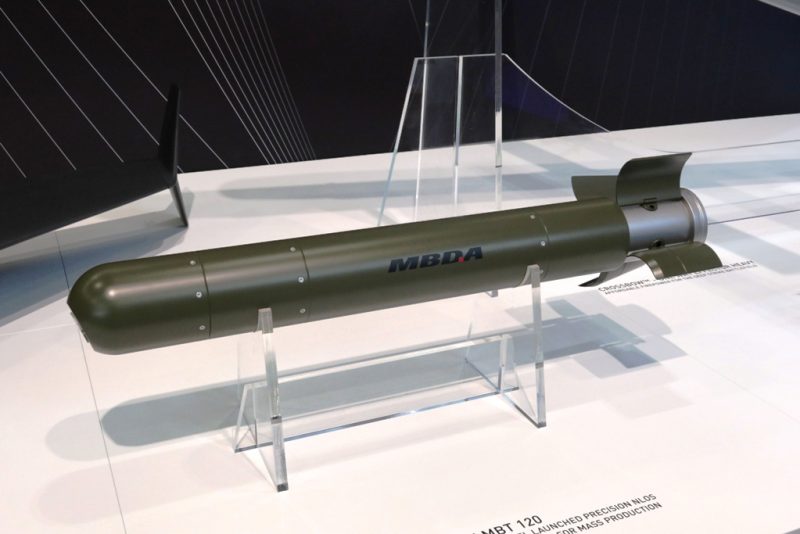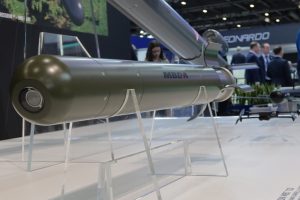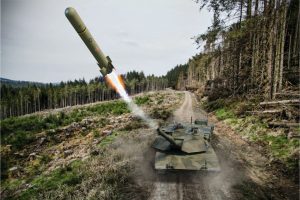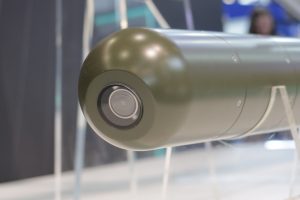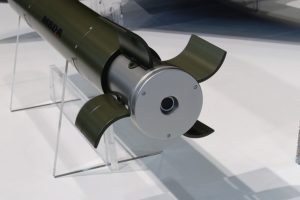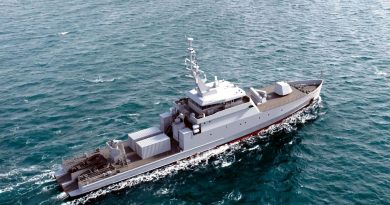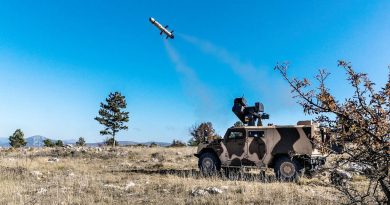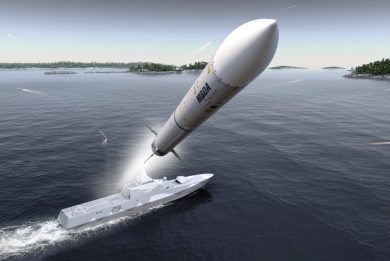DSEI 2025 – Akeron MBT 120, indirect fire power for tanks from MBDA
Providing integral indirect fire capability to main battle tanks, allowing them to hit non-line-of-sight targets with their own ammunition, at range, this was the idea that led MBDA, the European missile company, to develop the Akeron MBT 120, a gun-launched missile which is being unveiled at DSEI 2025
Gun-launched missiles are not new, although in the West they never found great success. The 6-inch (150 mm) MGM-51 Shillelagh round was designed to be launched by the M81E1 Rifled 152 mm Gun/Launcher which equipped the US Army M51 Sheridan, corrections being provided by an IR link between the missile and the tank. Developed during the Vietnam war it was never deployed in that conflict, and survived until the 1991 Gulf War, but very few were fired in action. In 202 CMI Defence (now John Cockerill) unveiled the Falarick, a laser-guided 105 mm munition co-developed with the State Kyiv Design Bureau “Luch”, designed to be launched from the Cockerill CV gun, itself a proprietary development. These are probably the few western gun-launched missiles developed until now. At DSEI 2025 MBDA unveils its Akeron MBT 120, which compared to the above mentioned systems, as well as to the Russian 9K119 Refleks and Ukrainian Kombat 125 mm missiles used in the Russian-Ukraine war [1] represents a considerable step forward: while all those seen until now are line-of-sight (LOS) systems, the new MBDA product is a non-line-of-sight (NLOS) round.
According to MBDA sources, in Ukraine main battle tanks engagement range seldom exceeds 1.5 km. To fully exploit the range of tank munitions tanks needed to get some form of indirect fire capability, launching their munition against unseen targets, which were acquired by other actors on the battlefield, such as unmanned air vehicles (UAVs) or targeting parties. These feed the data to a command post that assigns the task to an effector, an MBT armed with the typical 120 mm smoothbore gun in use on most Western tanks, which launches the round, according to the required azimuth and elevation.
Once the round leaves the barrel it starts a steep climb to gain altitude as soon as possible; depending on range, it then adapts its trajectory before diving onto its target in a deep top-attack mode. In this phase the guidance system brings the round over the target area based on coordinates received from the targeting network; once it reaches the target area the electro-optic imaging infrared seeker picks up the enemy vehicle signature and thanks to AI automatic target recognition algorithms guides the Akeron MBT 120 on selected right target, the top-attack mode allowing to hit the least protected areas of the MBT.
EDR On-Line understood that a final decision on the warhead has not yet been taken; what is clear is that it will be of the shaped charge type. To increase the round flexibility a fragmentation sleeve might be added, although this might reduce the shaped charge diameter, which is directly linked to the round penetration capability. A dedicated HE FRAG warhead might be another solution, should customers require it. This would allow the tank to neutralise soft targets in the NLOS mode. The warhead provider has not yet been identified, according to information gathered at DSEI. MBDA has an in-house solution, TDW being one of the two main European warhead designers and producers, the second being Saab Bofors Dynamics Switzerland being the other one; however a third option might arise, a UK solution which might not be the most efficient one under the cost profile, but it would make the Akeron 120 MBT a fully national British product.
Fully passive, the MBDA round does not triggers the enemy vehicle laser sensors, hence only active protection systems fitted with radars capable to detect incoming threats from the top sectors will be capable to react. Multiple rounds can be fired in sequence, eventually from different platforms, to saturate the target defences.
Being a fire-and-forget system the Akeron MBT 120 allows the firing platform to leave the firing position as soon as the missile exits the barrel, something pretty different from the above-mentioned laser beam-riding rounds which need the firing tank to track the target for several seconds, eventually exposing itself to retaliatory fire. EDR On-Line understood that the range is typical of MBT rounds, up to 5 km, tank crews seldom enjoying such a direct sight range.
The missile is fully respects the NATO 4385 STANAG, the agreement that ensures full ammunition interoperability for 120 mm smoothbore guns. Its footprint is identical to that of the other rounds, 120 mm diameter and 984 mm length, therefore it can be hosted in the same racks and autoloaders used for APFSDS and other 120 mm rounds, its mass being around 20 kg, comparable with that of other munitions.
The missile comes with a gun-fit casing that hosts the ammunition data-link; this ensures the link with the ammunition data interface contained within the breach block, through which the target characteristics are provided to the seeker, target grids being fed into the fire control computer (FCC) that calculates the gun azimuth and elevation. The addition of the programming element and the integration of the FCC software to cope with the external flight characteristics of the new round will be the only modification the user will have to do, to ensure the new round integration in its MBTs. Currently several MBTs are being fitted with a programming system to allow them to use Rheinmetall 120 mm DM11 high explosive programmable ammunition; EDR On-Line understood MBDA is talking to the German company to see if the same programming system might be exploited to feed data into its gun-launched missile. This would further reduce integration issues and eventually avoid installing two programming system in tanks already fitted with the DM11 solution.
The Akeron 120 MBT is not “fired”, it is “launched”, which means that no gun powder is included in the round, which leaves the barrel thanks to the thrust of a know efflux rocket motor. This allows to have a low acceleration, hence non-G hardened components must be used in the missile, which considerably helps in controlling costs, another positive side effect being that the soft launch system also reduces barrel wear. That said, considering the various ammunition developed or under development for MBTs, the new MBDA missile will be in the high-end. “It will be more expensive, but it will provide a vastly superior capability,” a company representative told EDR On-Line.
No precise data were provided on the round maximum speed, MBDA saying it will be “low supersonic”. The same applies to the maximum range, which is not announced, but as the Akeron 120 MBT can be fired at the maximum elevation, which in MBTs varies between 15° and 20°, this might be slightly higher than the LOS range for APFSDS rounds. This will reduce tank unit reliance on indirect fire support from the artillery, which will therefore be able to cope with targets deeper in enemy lines. As the capability is given by a new type of round, nothing is visible from the outside, therefore the enemy will not be able to understand if an MBT has NLOS capability or not.
At the last editions of Eurosatory new calibre guns for western tanks were showcased, the competition being between 130 mm (Rheinmetall) and 140 mm (KNDS France). MBDA is certainly looking with interest at those developments, adapting its gun-launched missile to bigger calibres being a relatively simple operation. The European missile company is “trying to get ahead of the capability gap, anticipating the requirement rather than waiting for it to be formally stated,” an MBDA source stated.
MBDA aims at starting demonstration firings in one year time and being able to bring the Akeron MBT 120 in service one year later.
[1] Both the Russian 9K119 Refleks (and the Refleks-M improved version) and the Ukrainian Kombat are 125 mm laser beam-riding, gun-launched, anti-tank guided missiles, that can be fired from platforms such as T-64, T-72, T-80, T-84 and T-90S. The guidance is provided by the modulated laser beam; this needs the target to be in sight, while the beam must remain on target all the time, increasing the danger for the launching platform, especially if the target is equipped with a laser warning receiver.
Graphic courtesy MBDA, photos by P. Valpolini

